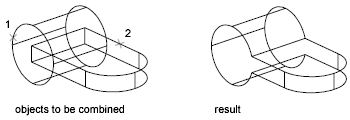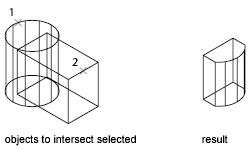Composite solids are created from two or more individual solids through any of the following commands: UNION, SUBTRACT, and INTERSECT. (FILLET and CHAMFER also create composite solids.)
By default, 3D solids record a history of their original forms. This history allows you to see the original forms that make up composite solids. For more information about History settings for solids and surfaces, see Display Original Forms of Composite Solids.
With UNION, you can combine the total volume of two or more solids or two or more regions into a composite object.

With SUBTRACT, you can remove the common area of one set of solids from another. For example, you can use SUBTRACT to add holes to a mechanical part by subtracting cylinders from the object.

With INTERSECT, you can create a composite solid from the common volume of two or more overlapping solids. INTERSECT removes the nonoverlapping portions and creates a composite solid from the common volume.
